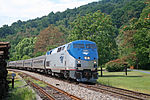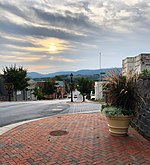Blue Ridge Tunnel

The Blue Ridge Tunnel (also known as the Crozet Tunnel) is a historic railroad tunnel built during the construction of the Blue Ridge Railroad in the 1850s. The tunnel was the westernmost and longest of four tunnels engineered by Claudius Crozet to cross the Blue Ridge Mountains at Rockfish Gap in central Virginia. At 4,237 feet (1,291 m) in length, the tunnel was the longest tunnel in the United States at the time of its completion. The tunnel was used by the Virginia Central Railroad from its opening to 1858, when the line was reorganized as the Chesapeake and Ohio Railroad (renamed Chesapeake and Ohio Railway in 1878). The Chesapeake and Ohio routed trains through the tunnel until it was abandoned and replaced by a new tunnel in 1944. The new tunnel was named the "Blue Ridge Tunnel" as well, although the original tunnel still remains abandoned nearby. The old Blue Ridge Tunnel has since been named a Historic Civil Engineering Landmark by the American Society of Civil Engineers in 1976. In late 2020, after a decade of stabilization work and restoration as well as access pathway construction, the tunnel was opened to visitors as a linear park.
Excerpt from the Wikipedia article Blue Ridge Tunnel (License: CC BY-SA 3.0, Authors, Images).Blue Ridge Tunnel
Historic Crozet Tunnel,
Geographical coordinates (GPS) Address External links Nearby Places Show on map
Geographical coordinates (GPS)
| Latitude | Longitude |
|---|---|
| N 38.0383 ° | E -78.8625 ° |
Address
Historic Crozet Tunnel
Historic Crozet Tunnel
22998
Virginia, United States
Open on Google Maps









